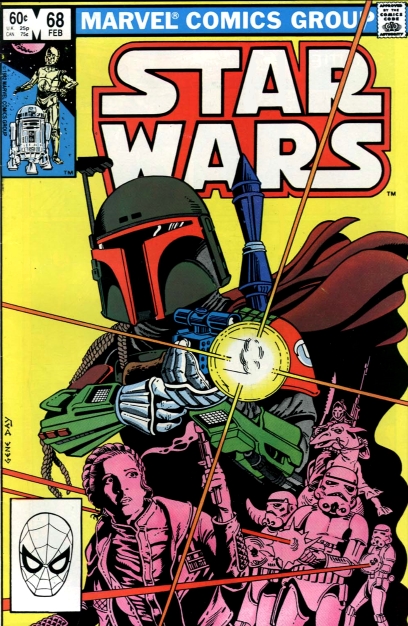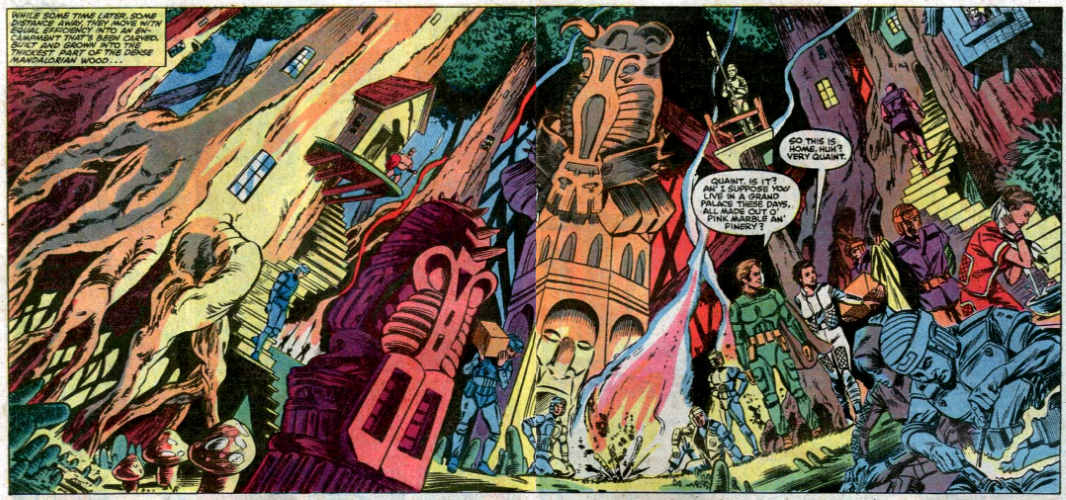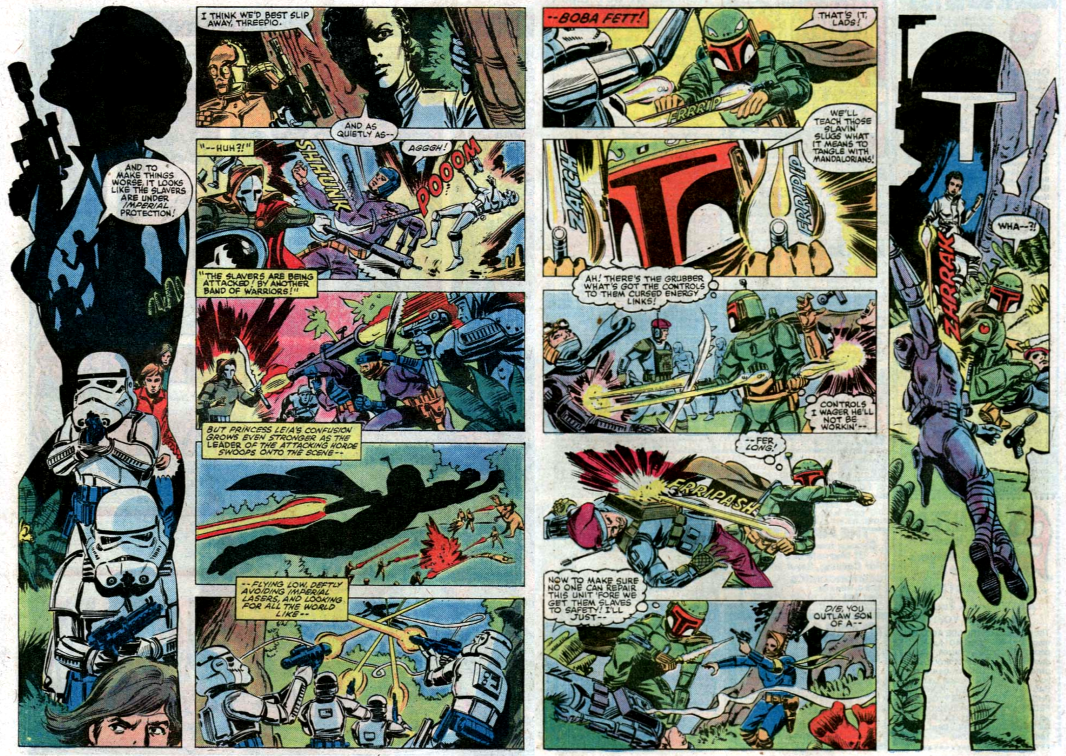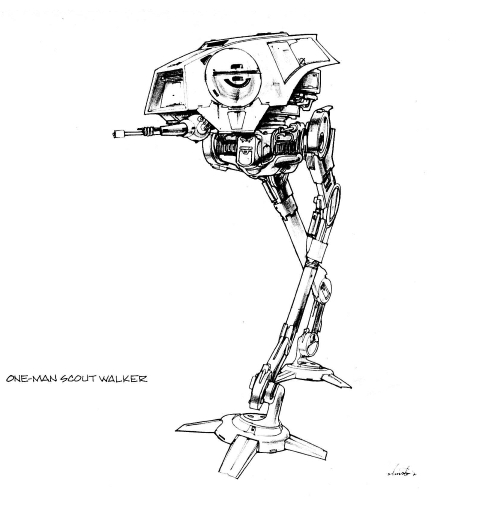Star Wars #68Cover dated: February 1983
Issue title:
The Search BeginsScript: David Michelinie
Artwork: Gene Day (layouts)/Tom Palmer (finished art & inks)
Colours: Glynis Wein
Letters: Joe Rosen
Cover art: Gene Day
Overall rating: 10 out of 10
 Plot summary
Plot summary: The Rebels have learned that the bounty hunter Boba Fett was in league with another mercenary at the time he captured Han Solo. However, Fett cut this other bounty hunter out of the deal when he left Cloud City with Solo frozen in carbonite. Working on the assumption that the bounty hunter in question might still bear a grudge against Fett and, for a price, divulge where Fett is hiding before his rendezvous with Jabba the Hutt, Han's Rebel friends set out to track down each of the suspects. Princess Leia and C-3PO are tasked with tracking down the bounty hunter Dengar, while Luke Skywalker, Lando Calrissian and Chewbacca head off to locate IG-88 and Bossk.
Leia and 3PO head for the planet Mandalore, which is the last known location of Dengar. Landing on the planet's surface, the pair soon stumble across a band of slavers, with a group of Mandalorian prisoners in tow. As Leia and the droid watch, the slaver's caravan comes under attack from a group of warriors led by someone who looks like Fett. Leia impulsively joins the fight on the Mandalorian's side and, at one point, ends up saving the life of the individual that she assumes is Fett. As the battle finishes, the leader of the Mandalorians reveals that he is, in fact, Fenn Shysa, an old comrade of Fett's.
Fenn takes the Rebels back to his camp and explains that in the years since the Clone Wars he has fought to free his people from the Empire's slavers. Shysa also tells Leia about his time serving as a Mandalorian Supercommando in the Clone Wars, during which Fett was his chief officer. Shysa recounts how all but three of the Supercommandos were killed in battle, prompting a disillusioned Fett to leave the unit and become a bounty hunter, while he and his childhood friend Tobbi Dala stayed to fight for the Mandalorian people. Leia asks Fenn whether he has encountered Dengar and is surprised to learn that the bounty hunter is currently his prisoner. However, Shysa refuses to hand him over to the princess because Dala has been captured by the Empire and the two warring sides plan to exchange prisoners the following day.
That evening, while enjoying a pleasant walk with Fenn, Leia knocks the former Supercommando unconscious and, with 3PO's help, frees Dengar from his cage. Leading the bounty hunter away from the Mandalorian encampment at blasterpoint, Leia questions him about Fett's whereabouts, but the mercenary has secretly activated a tiny homing device on his wrist. Moments later, a huge Imperial AT-ST scout walker bursts through the trees, as a squad of stormtroopers appear from the undergrowth, surrounding the princess and 3PO.
Comments: OK, this is going to be a longer than usual review because there's an awful lot of ground to cover regarding the contents of
Star Wars #68. This comic is essentially the start of two separate story arcs, which I tend to group together under the overall heading of The Search for Han Solo. This issue and #69 contain the Mandalorian arc, which focuses on Princess Leia and C-3PO's search for Dengar, while the Stenax saga in issues #70–72 follows Luke Skywalker, Lando Calrissian and Chewbacca's search for IG-88 and Bossk. Before I get into the main part of my review, I'm going to discuss the rationale behind the Search for Han Solo and the continuity problems with this issue's depiction of the Mandalorian Supercommandos. Feel free to skip these parts if you just want to read the review.
The Search for Han Solo:The first thing I probably need to address is why there's any need for the Rebels to search for Han Solo in the first place. After all, we know that Boba Fett captured Solo in
The Empire Strikes Back in order to take him back to the gangster Jabba the Hutt, who lives on the planet Tatooine. So why aren't the Rebels just heading directly for Tatooine?
Well, at the end of
Empire, Lando says to Luke and Leia, "When we find Jabba the Hutt and that bounty hunter, we'll contact you", to which Luke replies, "I'll meet you at the rendezvous point on Tatooine." Lando then says to Leia, "Princess, we'll find Han. I promise", with Luke replying, "Chewie, I'll be waiting for your signal." It's clear from this dialogue that, although Luke, Leia and the others know that Fett will eventually take Solo to Tatooine, they know that Fett won't be going directly there. Otherwise, why would the Rebels need Lando to contact them when he has located Fett and/or Jabba? The Rebels know that some searching will be required, otherwise the end of the second
Star Wars movie would just be Luke, Leia, Lando and Chewie saying, "OK everybody, let's get to Tatooine and rescue Han!"
In reality, of course, the ongoing search for Solo in the comic book was also necessitated by the fact that Marvel had three years of comics to fill between the release of
Empire and
Return of the Jedi, during which time they couldn't have Han being rescued. But, as I've explained, Fett hiding out somewhere with Solo's frozen body, before delivering it to Jabba, does sort of fit in with the films. It was also a godsend for the writers of the comic in those inter-sequel years, because the search could end up getting broken off and then re-started again, as other threats loomed over the Rebellion, providing perfect plot fodder for the ongoing comic narrative.
The reason the Rebels went searching for Han, instead of waiting until he was deliverd to Jabba, was presumably because it would be much more difficult to rescue their friend from Jabba's palace and also because they wanted to save him sooner, rather than later. Of course, rescuing Han is something that the Rebels ultimately failed to do in the comics, which is why we get the rescue attempt at the start of
Return of the Jedi. So, I think Marvel got it pretty much spot on, in terms of how their comics fit in with what happened in
Empire and
Jedi.
The Mandalorian Supercommandos:Unfortunately, this issue's history of Boba Fett and the Mandalorian Supercommandos doesn't fit in with established
Star Wars continuity at all. By the time that this issue was published in late 1982, fans had already learned a tiny bit about Fett's backstory, but this issue gave us a wealth of hitherto unknown information about the bounty hunter and his involvement in the Clone Wars. The
Empire Strikes Back novelization had already described Fett's armour as having been worn by a group of "evil warriors defeated by the Jedi Knights during the Clone Wars." Then, in
The Empire Strikes Back Sketchbook, we learned that Fett's armour was initially designed by Ralph McQuarrie and Joe Johnston to be worn by a squad of Mandalorian Supercommandos, but Johnston later refashioned the costume for the character of Fett. Writer David Michelinie obviously read both of these scraps of information and then decided to combine them, making
Star Wars #68 the very first time that Fett is described as both Mandelorian and as an ex-Supercommando who battled against the Jedi in the Clone Wars. It's just a shame that, as the expanded
Star Wars universe has grown – particularly with the release of the prequel trilogy – much of what is revealed in this issue wound up being inaccurate.
For example, Fenn's version of events, in which Fett and the Mandalorian Supercommandos fought on the side of the Empire during the Clone Wars, appears to contradict what we see in
Star Wars: Episode II – Attack of the Clones. Fett was only 10-years-old at the start of the Clone Wars and was the unaltered clone of the bounty hunter Jango Fett. Fenn also tells Leia that the Supercommandos were sent into action during the Clone Wars after Emperor Palpatine had founded the Empire, but the prequel movies show that the Clone Wars occurred before the formation of the Empire. In addition, Fenn claims that it was during the Clone Wars that he first became aware of Leia, but that's impossible since Leia hadn't even been born at the time of the Clone Wars. While a lot of these continuity goofs aren't actually Michelinie's fault, since little or nothing was established about Fett's life during the Clone Wars when this comic was written, he really should've known, based on the information that was available at the time, that Leia was much too young to have been around during the Clone Wars.
Review:Anyway, criticisms of stuff that doesn't align with accepted
Star Wars canon and justifications for the search for Solo aside, this is a fantastic comic. For one thing, the artwork is simply gorgeous – a real treat for the eyes. The art in this issue is by Gene Day, who had previously served as one of the inkers on Marvel's
Star Wars series during Carmine Infantino's tenure as artist. While I was never a particularly big fan of Day's inking, feeling that it often made the cast's faces look overly-harsh or ugly, his work on this issue is superb. Right from the powerful opening splash page of a desperate-looking Leia kneeling before the ominous form of Han Solo entombed in a block of carbonite, the artwork is wonderful, with some exquisite double-page spreads, like this one...

I also love the inventive panel composition that Day employs; in particular, the use of Leia and Fenn-shaped silhouettes as comic panels in these two pages is very imaginative and gives the artwork a wonderful sense of symmetry...

Along with inking earlier issues of the series, Day had also advertised a
Star Wars portfolio in the first issue of Dave Sim's
Cerebus comic, back in 1977. Unfortunately Lucasfilm denied Day permission to sell the portfolio and so all copies of it were destroyed, except for Day's personal copies. If you're interested in seeing it, you can view the entire portfolio on Flickr.com, here...
www.flickr.com/photos/8117508@N08/sets/72157600160103014/with/478465858/What's particularly interesting about those early
Star Wars drawings of Day's are that even though they are dated 1977, the earliest year of
Star Wars fandom, his depictions of the various spaceships and other
Star Wars tech are miles better than the annoyingly inaccurate renditions that the comic's regular penciller, Carmine Infantino, was turning out as late as 1980.
Anyway, just to prove that I'm a real smarty pants and a big know-it-all when it comes to
Star Wars, I'd like to point out that the final panel of this comic features a sneaky swipe, pinched from Al Williamson's artwork in the
Star Wars newspaper strip. The drawing of an Imperial AT-ST scout walker on the left is from Williamson's February 22nd, 1981 instalment of the
Star Wars comic strip, while the panel on the right is Day's...

The reason that the scout walkers in these two pictures look slightly different from the the ones we saw in
The Empire Strikes Back and
Return of the Jedi is because Williamson based his drawing on an early concept sketch for the walker by Joe Johnston (see below), rather than the finished model, and Day simply copied Williamson...

That's enough of me showboating and showing off my knowledge of
Star Wars minutiae!

Suffice it to say that Day does a great job with the art here, ably abetted by Tom Palmer's detailed inking. In fact, based on his art in this story, it's tempting to wonder what the series would've looked like under Day's pencil, rather than Ron Frenz's. I mean no disrespect to Frenz though, because his art is great too, but it's interesting to ponder nonetheless. There's also some great colouring in this issue by Glynis Wein.
Sadly, Gene Day died young from a coronary on 23rd September 1982. In fact, he had actually been dead for two months by the time that this issue hit the stands in November 1982. Based on that, I'm guessing that
Star Wars #68 and #69 must have been some of his last completed work. What a fitting tribute these issues are to the man and his ability to draw great comics.
It's difficult to overstate the impact that
Star Wars #68 had, in terms of shaping the "Cult of Fett" among
Star Wars fans. Back in 1982, Fett was already a firm fan favourite, but information about him was scant. In this issue we got plenty of detail about the bounty hunter's past and we got to see images of the Mandalorian Supercommandos for the first time. I can clearly remember what a huge talking point the information gleaned from this issue was among my friends and fellow nerds, back in the day, and I'm sure that the same was true right across
Star Wars fandom.
Michelinie's plot is gripping and his scripting is as top-notch as usual. The central cast's dialogue is very in character, as we've come to expect from him, and the action sequences are fast-paced and very
Star Wars-y. It's a shame that Hutt, as in "Jabba the...", is misspelled again in this issue, because Michelinie got it right last issue. On the plus side, it's great to see a Mandalorian Supercommando like Fenn Shysa in action and see just how formidable they and their armour could be. Fenn's a pretty good character too and certainly a memorable one, although I could've done without the cod Irish or Scottish accent that Michelinie gives him.
While we're on the subject of Mandalore, it's interesting that the Empire is involved in a slaving operation there. That certainly makes sense, especially when you look at how the Empire subjugated and enslaved the Wookiees of Kashyyyk. As Fenn correctly states in this issue, the Empire always has need of slave labour to work in its mines and factories, to keep the Imperial war machine running. Of course, earlier in the series (issue #30, in fact) we saw the Imperial factory planet of Metalorn, which had just such a slave population.
Leia is written very well in this issue, just like the brave, resourceful and, at times, ruthless leader she should be. We also get to see how much Leia misses Han. I mentioned in my reviews of
Star Wars #61 and #65 that Michelinie was beginning to write Luke and Leia's relationship as a much more platonic affair than it had been previously, while simultaneously making it clear that Leia was very definitely in love with Han and
not Luke. In this issue, he again makes Leia's feelings for Han crystal clear, describing the "deep, abiding love" that she has for the Corellian smuggler. I suspect that, by this point in the series, with
Return of the Jedi well into post-production, word had come down from Lucasfilm instructing Michelinie to terminate the Luke/Leia romance.
Overall, this really is a fantastic issue of
Star Wars and it also sports one of my favourite covers from the series too (I've seen Day's striking cover artwork emblazoned on official
Star Wars t-shirts recently, which is nice). It's a shame that so much of this issue contradicts what we eventually saw in the prequels, but this is such a well written and drawn comic book that, even with its glaring continuity errors, I'm still gonna award it full marks. This is a gem of an issue and comes highly recommended by me.
Continuity issues:
- Fenn Shysa says that the Mandalorian Supercommandos fought for Emperor Palpatine during the Clone Wars, but the prequel movies make it clear that the Clone Wars took place before Palpatine declared himself Emperor.
- Boba Fett was 10-years-old at the start of the Clone Wars and was the unaltered clone of the bounty hunter Jango Fett, not an adult Mandalorian Supercommando.
- Fenn Shysa claims to have first become aware of Princess Leia during the Clone Wars, but as Star Wars: Episode III – Revenge of the Sith shows, Leia wasn't born until the Clone Wars had ended.
Favourite panel:
 Favourite quote
Favourite quote: "Well, I certainly hope
that will teach you not to accost a protocol droid! Ruffian!" – C-3PO rebukes an unconscious slaver that he has inadvertently defeated.